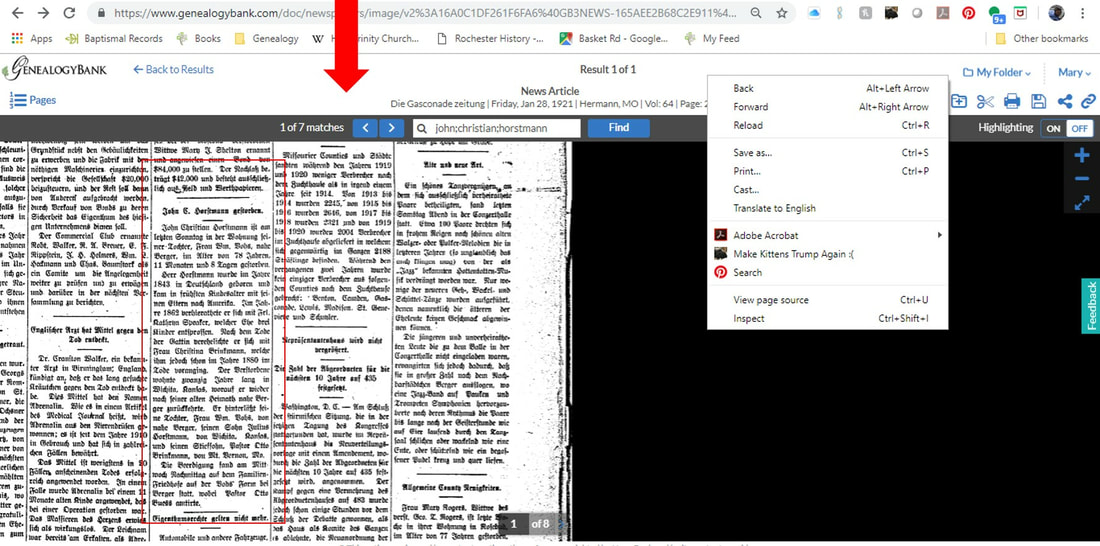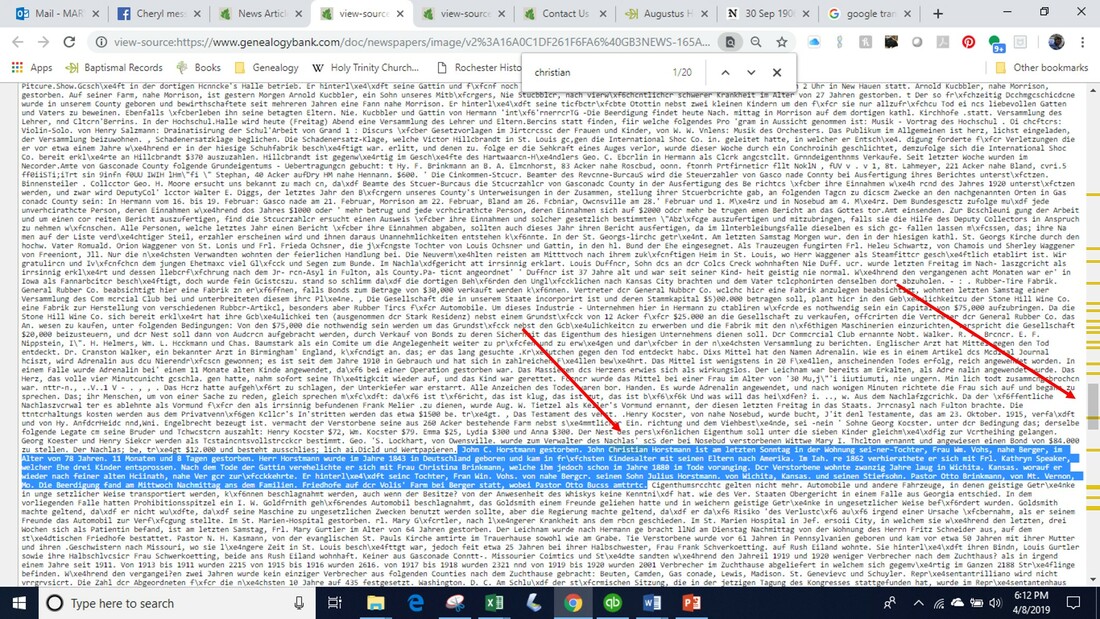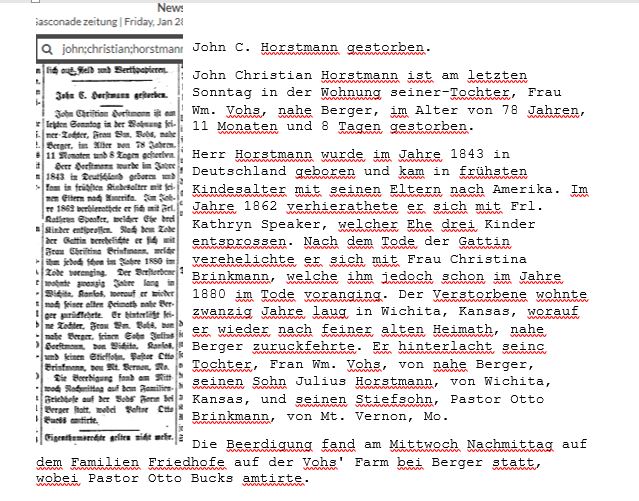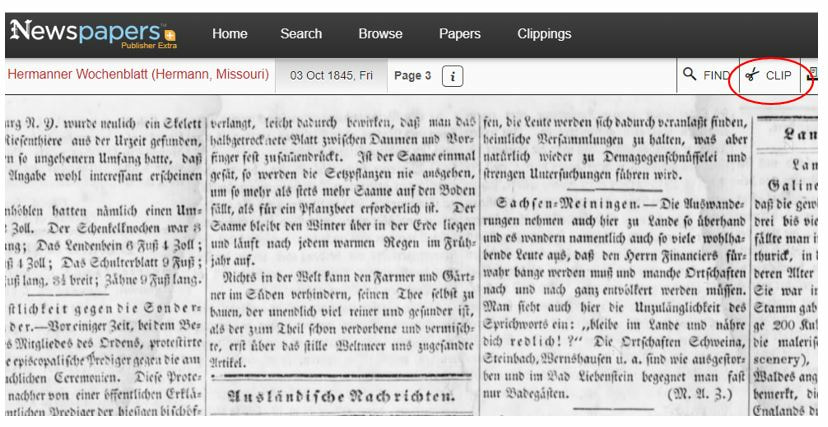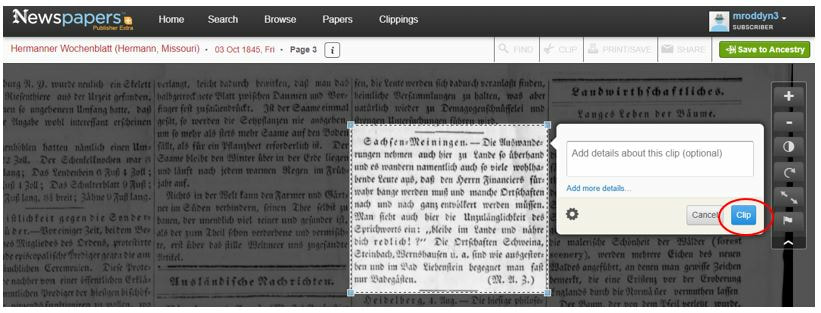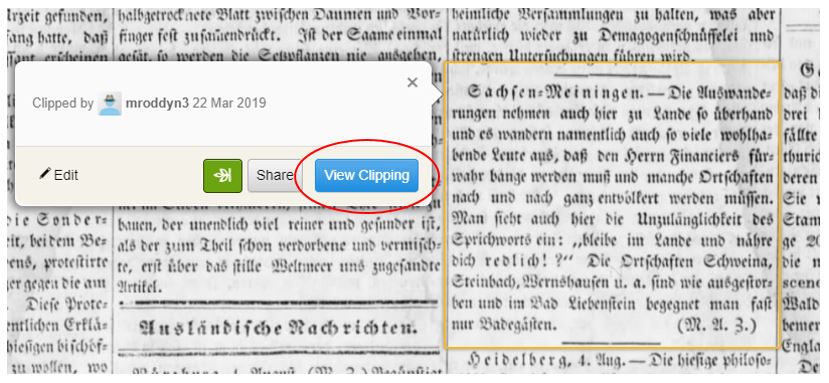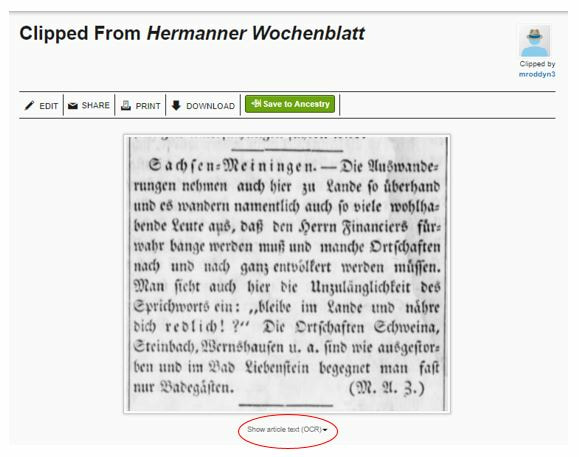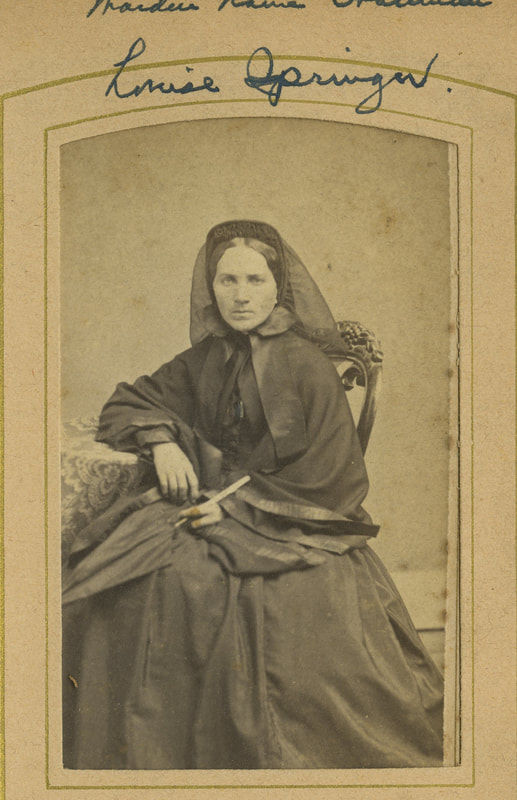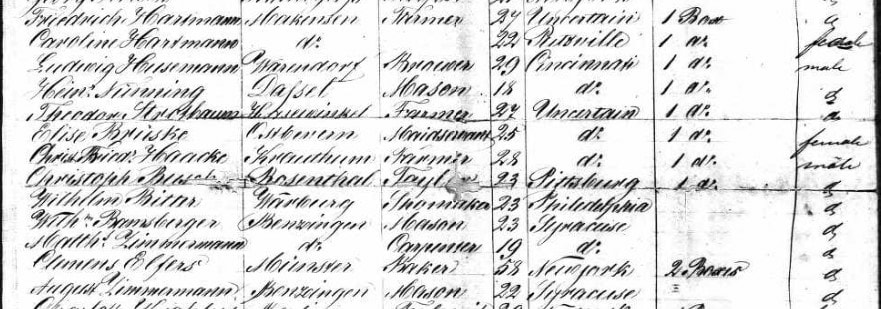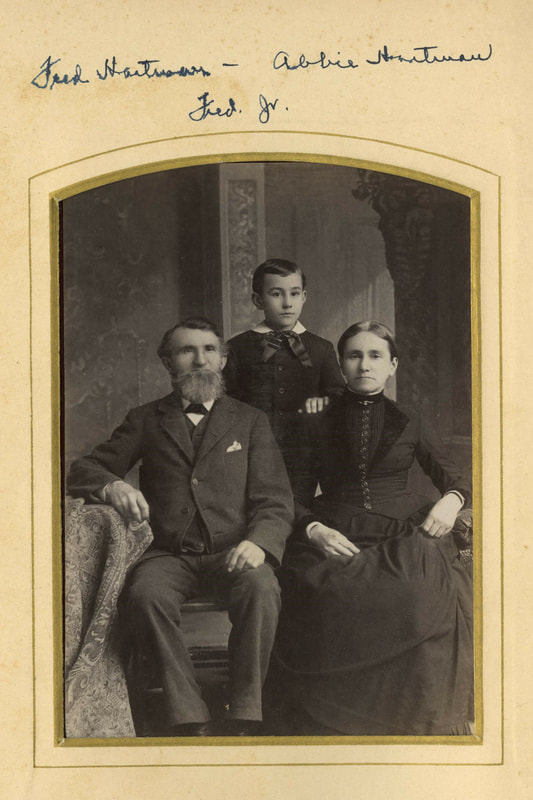|
A few weeks ago I blogged about how to translate German newspapers on Newspapers.com. Today, someone on facebook asked a similar question, but her paper was on GenealogyBank. I knew enough to know that if you can type a name in the search box and get a hit, somewhere behind the scenes there must be a little squirrel in a cage who matches what you type with the OCR files. But where the heck is that squirrel hiding on GenealogyBank? So I asked… Yes, those live chat opportunities on your favorite websites can be a great source of info. I asked “Mike” at GenealogyBank and he didn’t know the answer, but got back to me a while later via email. And yes, it’s doable! Find the article you want on GenealogyBank. I’m using a German-language paper, because generally I can read the English ones, but I need help with the German ones. My target article is the one in the red box. I can read enough of the Fraktur font to know the first couple of words in my article are “John C Horstmann gestorben” and the last words are “Pastor Otto Buess amtirte.”[1] That will be important… Right click anywhere in that white header at the top where my red arrow is pointing. You’ll get the dropdown box shown. Click where it says “View page source.” Get ready, folks… it’s not pretty. You can see the little gray bar on the right, showing how long this page is. And the entire thing is filled with this little teeny tiny print. Ugh. But Ctrl+F is your friend. That will bring up a search box. Use that to search for one of the words in your article. I figured “John” was probably on the page a lot, “Christian” not so much, so I chose that. GenealogyBank highlighted all the instances of “Christian” in yellow, so it was pretty easy to spot the one I wanted. Interestingly, though the newspaper page is laid out in columns, the OCR goes article by article. (I haven’t experimented enough to know if this is always the case, but for this example it definitely worked. Fingers crossed for your searches.) So it was pretty easy to highlight the whole article I was looking for. (Remember where I told you above that knowing the first few and last few words of your article would be important? Now you know why!) I pasted that text into a Word document. I also put a clipping of the article in the Word document (as an image). When I click on the article image, Word brought up the Format tab. On that I clicked on the “Wrap Text” icon and selected “Tight.” This put the image and the copied text right next to each other. There were a few errors in the text, but surprisingly not as many as I anticipated. But with the article image and the text right next to each other, it took me a only few minutes to clean it up. Once I had what I thought was correct, I copied that and pasted it into GoogleTranslate (https://translate.google.com). And I had my translation! I know, I know, GoogleTranslate is not perfect, but it’s perfecter than I am with my rudimentary German skills. And it’s fast. I can quickly get the gist of the article and determine if it’s of interest. So that’s my quick trick today to translate those pesky funny-font foreign language newspapers. I hope it helps you discover more about the stories of your ancestors. [1] “John C. Horstmann gestorben,” Die Gasconade Zeitung (Herman, Missouri), 28 January 1921, p. 2, col. 4; digital image, GenealogyBank (https://www.genealogybank.com : accessed 8 April 2019).
0 Comments
I recently posted about how to translate German books. Today I saw a post on the "German genealogy & cultural history" Facebook groupabout how to translate from Newspapers.com. I wanted to know, too, so I figured out a solution. It’s pretty simple. Find an article you would like to translate on Newspapers.com. Click on the “Clip” icon above the newspaper page and draw a box around the article you want to translate. After you’ve selected your text, click on the blue “Clip”. A window will pop-up prompting you to “Share” or “View Clipping”. Click on “View Clipping”. That will revise the view to show only the clipped portion. Notice underneath the article the words “Show article text (OCR)”. Click on that. Voila! the text magically appears. It is not perfect. I’m sure there are errors in this text. I can see an “i”, possibly because my clipping included the vertical lines on the left and right of the article. There could be other glitches, as there often are with Optical Character Recognition (OCR), depending on the quality of the image, but at least I have something. Now I can copy the transliterated text and paste it into GoogleTranslate. , GoogleTranslate is not perfect, either, but hopefully I can get the gist of the clipped article. If I want a better translation I can hire a translator to translate the original article. Pretty quickly I was able to be able to roughly “read” this foreign language article. What foreign language newspaper are you going to search first? Sometime in the 1970s my dad’s first cousin Thelma Wooster Van Alstyne typed up some genealogy information on her great-grandparents, immigrants from Germany. Her two reports provided information on my great-great grandparents, two immigrants couples, Charles Kircher and his wife Augusta Frühauf who met and married in Germany before emigrating, and Johannes Springer of “Kappeln” in Bavaria and his wife Louisa Caroline Hartman of Hanover, Germany, who came to America separately and were likely introduced to each other by common friends in Syracuse, New York. Thelma’s charts gave the birth, marriage and death dates for these couples and all their descendants she knew about at the time she prepared the charts. In addition to the charts she wrote up a dozen or two paragraphs of “Notes” on each couple. There is not one source cited on any of the notes or descendancy pages. Thelma must have had some documents. There are photocopies of some records from Germany for the Kirchers, including an 1849 passport from the Royal Prussian States and a couple of documents reporting on baptisms which were likely provided by the couple to the pastor who married them. Thelma had the documents transcribed and translated. With some of the other documents I only have copies of the translations, and no idea where the original documents are. God bless Thelma for doing as much as she did. Without it, much of the history would have been lost. I’ve tried to go back and prove what Thelma had in the trees and notes. Most of it was accurate, at least to a degree. I have not found a Kappeln in Bavaria, but there is Kapellen, and using microfilm and digitized records from the Family History Library I found Johannes Sprenger’s baptism record. In fact, for three of those four immigrant great-great grandparents, I found original baptism records, and in several cases I’ve been able to work back another generation or two (or more!) on German soil. But one of them had me stumped. Louisa Caroline Hartman of Hanover. Hanover is the name of a city, as well as a former kingdom, in what is now Germany. It is neither a small nor a very specific place. Here’s all the information about Louisa I had from Thelma’s “Notes on the Springer Family”:[1] Johannes Springer had four brothers and sisters. The Hartmans in Germany had money. Louisa’s parents didn’t want her to come to America, so she probably didn’t get any of the family’s money. The Springer’s in Liverpool[2] were poor. Grandma (Frances) and Aunt Amelia used to pick up sticks for fuel near the salt mine. Relatives in Liverpool and Syracuse: Hartmans (Nellie, Fred, Nick, Amelia Hartman Klassi), Getmens, Bauers (Mrs. Bauer was a Hartman). The descendency chart started with: LOUISA CAROLINE HARTMAN M. 1st JOHANNES SPRINGER B. June 3, 1836 (Hanover, Germany) B. 1835 (Kappeln, State of Bavaria) D. May 1, 1905 (Buried in Union Hill) D. Oct. 3, 187- (Age 42) Liverpool, NY[3] Hanover... Ugh. But the notes listed some Hartman cousins in Liverpool and Syracuse. Nellie, Fred, Nick and Amelia Hartman Klassi. I like that Klassi name – unusual enough to hopefully be easy to find. Sure enough, found an obituary, “Mrs. Frank Klassi Dies at Daughter’s Home.” The article title is wrong, but the text is just what I was looking for: At the residence of her daughter, Mrs Frank Klassi at No. 16- [?] Strong avenue yesterday occurred the death of Mrs. Abbie Frech Hartman, aged 73 years. Surviving her are three daughters, Mrs John L. Bauer, Mrs. Frank Klassi and Miss Nellie Hartman of this city and a son, Fred G. Hartman of Newark, N. J. Funeral services will be held privately at 2:30 o’clock tomorrow afternoon and burial will be at Woodlawn Cemetery.[4] As I searched more for this family I discovered through census records and obituaries the patriarch was Frederick August Hartman. (I think Thelma might have been slightly off listing Nick as a Hartman. He appears to be a cousin on the other, Springer, side. Nick Springer and Sarah Gettman were children of Johannes Springer’s brother Nicholas who lived next door to Louisa and Johannes in Liverpool.) The pieces began to fit together. Louisa Hartman Springer’s daughter, Franklin Abelone was baptized on 14 June 1857 in Liverpool. Her godparents were Frederick Hartman and Abelone Hartman. Cousins. Godfather. Yes, Frederick Hartman was beginning to look a lot like he must be Louisa’s brother. I ordered both Frederick and Louisa’s death certificates. Not cheap to get New York vital records, but surely one of them would tell me the parents’ names and the birthplace in Hanover… And the records came! Louisa was born in… Germany. Her father was Anthony Hartman, born in… Germany. Her mother was Mollie Hartman, born in… Germany. Louisa was 68 years [months and days not givene] at her death on 1 May 1905.[5] Not exactly the specific details I hoped for. What about Fred? Fred’k A. Hartmann, died 19 May 1902 at age 79 years, 3 months and 25 days. He was born in… Germany. He’d been in the US 55 years. His father was Anton and his mother was Amelia, both from… well, you know… Germany.[6] But at least there was some math I could do. I calculated a birthdate of 24 January 1823. If, of course, the unnamed informant on the death certificate knew what they were talking about. The details on the two certificates meshed well enough. Anton and Anthony seemed a solid fit. Mollie is not a far stretch as a nickname for Amelia. Both Frederick and Louisa named daughters Amelia. And there things sat for a year and a half. I tried to work on the problem off and on. My attempts to find a marriage record in Liverpool for Johannes and Louisa met with stonewalling from the likely church where the baptisms of their children and probably their marriage occurred. I reached out to distant cousins, looking for a family bible which might say something. No bible, but my “new” cousin Amy had a fabulous photo album from Louisa’s daughter, Amelia. The album contained several Hartman pictures, including one of Abelone Frech Hartman with all her children, and one of Frederick and Abbie together. But I’m afraid with the scant clues I had: - aprobable birthdate for Fred, first names for parents but no maiden name for Mama, a Kingdom comprising about 14,600 square miles[7] (roughly twice the size of New Jersey)[8], - and little in the way of online records, I just didn’t have the stamina to tackle that problem. So many ancestors, so little time… In January I took a class at the Salt Lake Institute of Genealogy (SLIG)[9] from Warren Bittner, Baerbel Johnson and Daniel Jones on reading Gothic Script and Fraktur. It was a delightful experience, one of the most fun weeks of learning I have ever had. Five days of “code breaking” flew by, not one moment feeling like work. But now I have the confidence to take on those “chicken scratch” records which used to scare me to death. A couple of weeks after SLIG I had to go back to Salt Lake City for some meetings, and I built in some time for more research at the Family History Library. I was getting a bit of help from Daniel on a few bits I couldn’t read in a couple of records. Herr Bitter was there as well and I couldn’t resist sharing how excited I was about my new-found skills. I sat next to him later in the day and he worked at one computer and I at another, but every once in a while he offered a little advice on this or that. I saw him at the library several more times in the next few days. (I do hope I wasn't too much of a pest.) My Hartmann problem in the back of my mind, I thought I’d see if Warren had any ideas. I guess I was right about the size of the problem. When he asked who I was looking for and I said “Frederick Hartman in Hannover,” his response was a brief two words. “I’m sorry.” But a little later he wanted to see what I had on him and I showed him the 1855 New York census for Frederick in Syracuse. It showed he’d been in Syracuse 5 years. He was married and living with his in-laws who reported being in Syracuse 3 years, so it pointed pretty strongly to an immigration year within a couple of years of 1850. Warren said, “Why don’t you look for a passenger list for Frederick. You might find a few, you might find a lot. But it’s worth a shot.” Yeah, right, I thought. My experience with passenger lists has rarely been fruitful. I don’t know the name of the ship my guy came on, I don’t know when, I don’t know if the list for the ship he did come on survived, I don’t know if it was microfilmed… or indexed… or digitized. Was it legible enough that the indexer could come up with a reasonable approximation of the name? If it made it through all those hoops would it say anything more than “Frederick Hartman, age 25, laborer from Germany?” Below is my “typical” passenger list. The columns are: Number on the manifest, Name, Age, Gender, Occupation, The country to which they severally belong, and The country in which they intend to become inhabitants.[10] The name, age and gender columns at least have a bit of variety. The other three are laborer, Germany and U.S. of America. Even a 2-month-old baby on the next pages was a “laborer.” So, no… I didn’t jump right on Warren’s suggestion. But after a few more days of research, I’d exhausted the questions on the other “findable” lines and so I thought I’d at least give it a shot. I searched in Ancestry’s New York Passenger Lists database for a Frederick Hartman arriving in 1850 +/- two years. I got only 20 hits, so not too many to go through. Some I could immediately throw out based on the passenger’s age. Only one had a birth year of 1823, so I checked that one first. The Columbus arrived 6 April 1850 from Bremen. What I saw on that list had me drooling. The column headings might be a bit hard to read due to the ink splotches, but they are: Name, Last Dwelling Place, Occupation, Age, Destination, [no heading, but the entries show number of boxes of possessions] and Sex.[11] Look at those letters![12] Thank you D. Meyer, Master of Columbus. You are my hero! Your second grade teacher who taught you that beautiful penmanship is my hero, too! So what do we have here? Frederick Hartmann, from Makensen,[13] a farmer, age 27, uncertain about his destination, one box, male. Next line, Caroline Hartmann, [ditto, also from Makensen], 22, destination Pitsville [?], 1 box, female. Could this be Louisa Caroline? She’s a little old from what I know about Louisa, but if she subtracted a little in her later years (many women did) and added a few on this manifest (maybe she worried about appearing too young to support herself, so she tried to be a little older) she might be within range to be Louisa. But I’m pretty sure Frederick and, Caroline aren’t a married couple because they’re not going to the same destination. And look at 8, 9 and 11 lines below Caroline – Wilhelm Benzinger, Matthias Zimmermann and August Zimmermann – all three of them are going to Syracuse, where Frederick wound up. Imagine if you will, a ship full of people, lining up to give super scribe, D. Meyer, their particulars. Frederick really can’t decide where he’s going but there’s a trio just a bit behind him in line, all of them talking up the many opportunities of Salt City and Frederick is convinced. Do I know this is really what happened? Nope. But hey, it makes sense, right? I really like this passenger list. I could find it. It is legible. It has really specific information like Makensen and Syracuse. I sooooo want this list to be mine! Allow me a little digression… When I was a kid, I chewed a lot of Bazooka bubblegum, the pink stuff with the comics inside the wrappers. Often hard as a rock, but enough spit and you could get a pretty good chew. I cannot tell you much about the comics. But one, for some obscure reason, has stuck with me the last 50 years. Bazooka Joe is on his knees beneath a street lamp, clearly looking for something. His friend offers to help. Next frame his friend asks if this is where Joe lost his thingamabob. “No,” says Joe. “I lost it over there.” “Then why are we looking here?” “The light’s better over here.” I feel that way a lot in genealogy. Some record isn’t from where my ancestor was from, and it’s probably not them, but the “light” is better on the record. It’s legible. It’s got places - “Makensen!” and “Syracuse!” That is some great light! It just HAS to be my people. Please, please, please, genealogy gods, can this be my people? Pretty pretty please. The light is so good on this one. Well, I have absolutely no idea if the Hartmanns on the Columbus are my people. But Warren has given me the name of Detlef, a researcher in Hannover, who used to work at the Landeskirchliches Archiv Hannover. I’ve already emailed Detlef about a baptism record on a family in Einbeck, maybe he could look for a Mackensen record, too. So I gave Detlef those details, and crossed my fingers. Three days ago I heard back from Detlef. The microfiche from Mackensen was horrid, difficult to read and not worth taking a picture of. But it was legible enough at least to find some relevant entries. He found two baptisms on that crummy microfiche. Two children of Heinrich Anton Hartmann, a Schumacher [shoemaker], and his wife Johanne Amalie, born Schollens. Friedrich August Hartman, born in Mackensen 24 January 1823. And Johanne Dorothee Caroline Hartmann, born in Mackensen 14 March 1828.[14] Frederick’s was exact date calculated from his death certificate. That informant did know what they were talking about! Caroline’s baptism name doesn’t include the name Louisa. The birthdate is consistent with the Columbus passenger Caroline Hartmann, but the birthdate does not match Thelma’s details on Louisa Caroline. I think this might be another sister. My experience with my German families indicates children are often christened with three or even four names. The “first” name is often the name of a godparent, but the child may be called by one of the other names. When you’re doling the names out three-to-a-kid you run through them pretty quickly, so often the “extra” names are used for multiple children. So Louisa Caroline’s baptism record is still waiting for me to lay eyes on it, but I’m pretty darn sure I’ll find it in the parish registers of Mackensen. Can’t wait! Research takeaways
[1] A note on the names – the records in Germany use the spelling “Sprenger.” In America they use “Springer.” I will use the Springer variant unless I am talking about a record which uses Sprenger. [2] Liverpool is a small town on Lake Onondaga, northwest of Syracuse, where Johannes and Louisa settled. [3] “John” Sprenger died 3 October 1867 in Liverpool. His gravestone says he was 42 years old. This is close to the baptism record I found for Johannes Sprenger, born 30 April 1827, son of Jakob Sprenger and Elisabeth Scheib in the church register for Drusweiler, FHL microfilm 1457537 [4] “Mrs Frank Klassi Dies at Daughter’s Home,” Syracuse Post Standard, 3 December 1909, p. 7, col. 3; digital images FultonHistory (http://fultonhistory.com/Fulton.html : accessed 22 February 2019). [5] Monroe County, New York, death certificate no. 114 (1905), Louisa Bowman; Office of Vital Records, Rochester. [6] Onondaga County, Verified Transcript from the Register of Deaths, Register no. Vol. F, p. 101 (1902), Fred’k A. Hartmann; Office of Vital Statistics, Syracuse. [7]“Hannover,”GlobalSecurity.org (https://www.globalsecurity.org/military/world/europe/de-hanover.htm : accessed 22 February 2019). [8] “Size of States,” State Symbols USA (https://statesymbolsusa.org/symbol-official-item/national-us/uncategorized/states-size : accessed 22 February 2019). [9] Utah Genealogical Association, SLIG - https://ugagenealogy.org/aem.php?eid=36 [10] “New York, Passenger Lists, 1820-1957,” digital images, Ancestry (http://ancestry.com : accessed 14 December 2018), manifest, Bark Davenport, 9 May 1849, page not numbered, lines 125-130; citing National Archives and Records Administration (NARA), microfilm publication M237 (1820-1897), Roll 79. age 2 months; citing National Archives and Records Administration (NARA), microfilm publication M237 (1820-1897), Roll 87. [11] “New York, Passenger Lists, 1820-1957,” digital images, Ancestry (http://ancestry.com : accessed 8 February 2019), manifest, Columbus, arrival 6 May 1850, page 1 > New York, Passenger and Crew Lists (including Castle Garden and Ellis Island), 1820-1957 > Roll M237, 1820-1897 > Roll 087 > image 451. [12] Ibid, pg. 3, image 453. [13] According to Meyersgaz.org, the standard spelling is Mackensen. [14] Detlef Baehre, Hannover, Germany [(E-Address for private use)], to author, email, 19 February 2019, “Re: Christian Friedrich Gottlieb Kircher 1789 birth record at Kirchenbuchamt on Hildesheimer Str.” |
AuthorMary Kircher Roddy is a genealogist, writer and lecturer, always looking for the story. Her blog is a combination of the stories she has found and the tools she used to find them. Archives
April 2021
Categories
All
|
